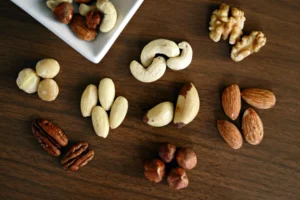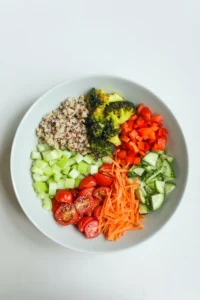Generated by Contentify AI
- Introduction
- The Benefits of Fiber
- Different Types of Fiber
- How Fiber Affects Digestion
- Recommended Daily Fiber Intake
- Sources of Fiber in Your Diet
- Tips for Increasing Fiber Intake
- Potential Side Effects of Consuming Too Much Fiber
- Conclusion

Introduction
Welcome to the wonderful world of fiber! Many people are not aware of the essential role that fiber plays in maintaining a healthy and balanced diet. We are here to provide you with an in-depth explanation of what fiber is, why it is important, and how to incorporate it into your daily routine.
Fiber is an indigestible substance found in plant-based foods such as fruits, vegetables, legumes, grains, and nuts. It is an essential component of our diet and is considered one of the most important nutrients for our health and wellbeing. Fiber plays a critical role in helping our bodies absorb and utilize essential vitamins and minerals. It helps keep our digestive system running smoothly and can even help us manage our weight.
There are two main types of dietary fiber: soluble and insoluble. Soluble fiber absorbs water and helps to slow digestion, while insoluble fiber adds bulk to stool and helps move food through the digestive tract. Both types of fiber are important for our health – we need both types to help keep our digestive system healthy and functioning optimally.
Fiber is a key part of maintaining a healthy lifestyle. It helps regulate blood sugar levels, lowers cholesterol, and reduces the risk of heart disease. It also helps keep us regula, aids in weight management, and can even help reduce cancer risk. Eating a diet rich in fiber can also help us feel fuller for longer periods of time, which can help reduce cravings and overeating.
Including fiber in your diet can be as simple as adding a few extra servings of fruits and vegetables to every meal. You can also add oats, whole grains, and beans to your diet. If you are looking for ways to add more fiber to your diet, try adding nuts, seeds, or even dried fruit to your snacks and meals.
Fiber is an important part of maintaining a healthy and balanced diet. We hope this article has helped you better understand the role of fiber in your diet and the importance of including it in your daily routine.
The Benefits of Fiber
Fiber is an important component of our diets, yet it is often overlooked in favor of the more glamorous aspects of good nutrition, such as protein, vitamins, and minerals. However, many people underestimate the numerous benefits that fiber provides and the positive impact it can have on their health and well-being.
First and foremost, fiber is a nutrient that helps us stay regular. Fiber passes through our bodies undigested and helps to keep things moving along in our digestive systems, reducing constipation and helping to prevent dangerous conditions like hemorrhoids and diverticulitis. Fiber helps us feel fuller for longer, enabling us to cut down on unhealthy snacking and making it easier for us to maintain a healthy weight.
Fiber also helps to bind to cholesterol and remove it from the body before it can be absorbed, thereby reducing the risk of heart disease. Fiber has also been linked to a reduced risk of diabetes, as it helps to regulate blood sugar levels. Additionally, fiber has been found to be beneficial to gut health, promoting the growth of healthy bacteria that aid in digestion.
In short, fiber can play an integral role in helping us stay healthy and achieve our dietary goals. Eating a balanced diet that includes plenty of high-fiber foods such as beans, legumes, nuts, whole grains, fruits, and vegetables can help us to reap the many benefits of fiber and keep our bodies running smoothly.
Different Types of Fiber
Fiber plays a critical role in your diet, as it is an essential component for maintaining a healthy lifestyle. There are two main types of fiber: soluble and insoluble. Both types of fiber are beneficial for your health, yet they have different functions and benefits.
Soluble fiber is found in foods such as legumes, oat bran, nuts, seeds, and fruits. It helps to reduce blood sugar levels, lower cholesterol, and prevent the absorption of dietary fat. In addition, it helps to slow down digestion, which can be beneficial for weight loss.
Insoluble fiber, on the other hand, is found in foods such as whole wheat, corn bran, nuts, and vegetables. This type of fiber helps to increase the bulk of your stool, which helps to move food through your digestive system more quickly and prevent constipation. It can also help to keep your colon healthy by preventing digestive disorders, such as diverticular disease.
When it comes to your diet, both soluble and insoluble fibers are important. Eating a variety of foods that are high in both types of fiber can help you meet your daily fiber needs. Furthermore, fiber can help you to feel fuller longer, which can help with weight management.
Overall, fiber plays an essential role in your diet and can have a major impact on your health. Taking the time to understand the different types of fiber and how they can help you reach your health goals will help ensure that you are getting the most out of your diet. So, take the time to understand the role of fiber in your diet and make sure that you are including both types of fiber in your daily meals.
How Fiber Affects Digestion
The role of fiber in digestion and overall health is often overlooked, yet it is an essential nutrient for the body. Fiber is a type of carbohydrate found in plant-based foods such as fruits, vegetables, grains, and legumes. It is essential for proper digestion as it helps to slow down the absorption of sugar from the food we eat, and it also helps to keep us regular by providing bulk for our stools and promoting regular bowel movements.
Fiber is important for digestion because it helps to break down the food we eat into smaller particles, making it easier for our body to absorb the nutrients. It also helps to stimulate the digestive system, which helps to prevent constipation and other digestive issues. In addition to this, fiber helps to lower cholesterol levels and can help to prevent the risk of cardiovascular diseases.
Fiber also helps to keep us feeling full for longer periods of time, which can help us to reduce our calorie intake and maintain a healthy weight. Furthermore, fiber helps to slow down the absorption of glucose in the bloodstream, which can help to prevent diabetes by managing blood sugar levels.
To ensure that you are getting enough fiber in your diet, it is important to include a variety of fiber-rich foods such as fruits, vegetables, whole grains, legumes, and nuts in your diet. You should aim to get between 25-35 grams of fiber per day, depending on your age and gender.
All in all, fiber is an essential component of a healthy diet. It helps to slow down the absorption of sugar, stimulates digestion, lowers cholesterol, and helps to manage weight. When you make sure to get enough fiber in your diet, not only are you supporting your digestion, but you’re also helping to keep your body healthy in the long run.
Recommended Daily Fiber Intake
Fiber is an important part of a healthy diet. It plays a key role in digestion, regularity, blood sugar levels, and cholesterol management. Unfortunately, most Americans don’t get enough fiber in their diet. In fact, the average American consumes about half the recommended daily amount of fiber.
The recommended daily fiber intake for adults is 25 to 30 grams. Most people’s diets consist of processed, refined foods that are low in fiber. If you want to increase your fiber intake, try to incorporate more high-fiber foods into your meals.
High-fiber foods tend to be nutrient-dense and provide a wide range of benefits. For example, whole grains, fruits, vegetables, legumes, nuts, and seeds are all good sources of fiber. Eating these types of foods helps keep your digestive system regular and may even protect against certain diseases, such as diabetes, heart disease, and certain types of cancers.
Incorporating high-fiber foods into your diet is important for your overall health and wellbeing. Eating enough fiber increases feelings of fullness and helps maintain healthy weight. Additionally, soluble fiber helps to lower cholesterol levels and is linked to reducing the risk of heart disease.
When increasing your fiber intake, it’s important to do so slowly. Eating large amounts of fiber at once can cause abdominal discomfort and diarrhea. Instead, gradually increase your fiber intake over a period of time and drink plenty of water to help keep your digestive system regular.
Understanding the role of fiber in your diet is key to maintaining a healthy lifestyle. Eating a variety of high-fiber foods can help you get the recommended daily amount of fiber your body needs. Incorporating more fiber-rich foods into your diet is essential for digestive health, weight management, and even reducing your risk of chronic diseases.
Sources of Fiber in Your Diet
Fiber is an essential part of a healthy diet, aiding in digestion, improving gut health, and helping to lower cholesterol. Unfortunately, many people don’t get enough fiber in their diets, falling short of the recommended 25-35 grams per day. Knowing where to get your daily dose of fiber can be tricky, so here is a comprehensive look at the sources of fiber in your diet.
Whole Grains
Whole grains are an excellent source of dietary fiber. Grains like oats, barley, and quinoa are packed with both soluble and insoluble fiber. Whole grains can be incorporated into your diet in many ways. Try adding some oatmeal to your breakfast, brown rice to your lunch, or popcorn to your evening snack.
Vegetables
Vegetables are another great source of fiber. Many vegetables, such as broccoli, Brussels sprouts, and squash, are high in insoluble fiber. Others, like carrots, beets, and potatoes, have a good combination of soluble and insoluble fiber. Eating a variety of vegetables will ensure that you get a good mix of both types of fiber.
Legumes
Legumes, like beans, lentils, and peas, are excellent sources of fiber. They are high in both soluble and insoluble fiber, as well as protein. Incorporating legumes into your diet is easy – they can be added to soups, salads, and even smoothies.
Fruits
Fruits contain both soluble and insoluble fiber, making them a great addition to any diet. Apples, oranges, and bananas are all good sources of fiber, as are many other fruits. Eating a variety of fresh and dried fruits will help you get the recommended amount of daily fiber.
Nuts and Seeds
Nuts and seeds are packed with fiber, making them a great snack. Almonds, walnuts, and chia seeds are all good sources of fiber, as are many other types of nuts and seeds. Try adding a handful of nuts or seeds to your morning yogurt or afternoon smoothie for an extra fiber boost.
So, there you have it – a comprehensive look at the sources of fiber in your diet. If you’re looking to increase your fiber intake, start incorporating more whole grains, vegetables, legumes, fruits, nuts, and seeds into your diet. Doing so will help
Tips for Increasing Fiber Intake
Fiber is an important part of a healthy diet. It helps keep you feeling full for longer, helps to fill you up more quickly, and can help reduce your risk of developing chronic diseases like diabetes, heart disease, and certain cancers. However, many people don’t consume enough fiber on a daily basis, so it’s important to take steps to increase your intake. Here are some tips for increasing your fiber intake:
1. Eat more fruits and vegetables. Fruits and vegetables are great sources of dietary fiber. Try adding a variety of fresh and/or frozen fruits and vegetables to your meals and snacks.
2. Choose whole grain products. Many refined grains (like white bread, white pasta, and white rice) have been stripped of their natural fiber content. Opt for whole grain versions of these products whenever possible. This includes whole wheat bread, brown rice, and whole wheat pasta.
3. Add beans and lentils to your meals. Beans and lentils are excellent sources of dietary fiber. Try adding them to soups, casseroles, salads, and other dishes.
4. Include nuts and seeds in your diet. Nuts and seeds are great sources of fiber and healthy fats. Try adding them to your salads, yogurt, oatmeal, or trail mix.
5. Include high-fiber snacks. Snacks like popcorn, whole grain crackers, and fruit are great sources of fiber. Try to consume these snacks regularly throughout the day.
By following these tips, you can easily increase your fiber intake and reap the health benefits.
Potential Side Effects of Consuming Too Much Fiber
Have you ever wondered if there is such a thing as consuming too much fiber? You’ve heard of the numerous health benefits associated with consuming a high-fiber diet, but it turns out that you can have too much of a good thing. While fiber is beneficial for your overall health, consuming too much of it can lead to some uncomfortable side effects.
The first side effect of consuming too much fiber is bloating and flatulence. Fiber helps to move things along in the digestive tract, but if too much of it is present, the digestive system can become overloaded. This can lead to uncomfortable bloating, as well as an increase in flatulence.
Another potential side effect of consuming too much fiber is constipation. Fiber adds bulk to stools, which helps them to pass more easily through the digestive tract. If you consume too much fiber in a short period of time, it can lead to a hardening of the stool, making it more difficult to pass.
Consuming too much fiber can also lead to an electrolyte imbalance. Fiber is known to bind to minerals like calcium, magnesium, and potassium, which can lead to an electrolyte imbalance. Electrolyte imbalances can lead to nausea, fatigue, and even heart palpitations.
Finally, consuming too much fiber can lead to a feeling of being overly full. Fiber helps to slow down digestion and make us feel full, so if you consume too much of it, you may find yourself feeling overly full and unable to eat.
In conclusion, it is important to be aware of the potential side effects of consuming too much fiber. While it is beneficial to consume a high-fiber diet, it is important to be aware of the potential side effects of consuming too much of it. To ensure that you are consuming the right amount of fiber, it is important to speak to your doctor or dietician to determine what the right amount is for you.
Conclusion
It is clear that fiber plays an essential role in a healthy and balanced diet. Fiber is important for digestion, weight loss, and overall health. Studies have shown that those who consume a diet rich in fiber may have lower risk for heart disease, stroke, and some types of cancer. It is also important to note that not all fiber sources are created equal. Some sources such as fruits, vegetables, nuts, and seeds provide more fiber than others such as grains. Additionally, fiber can come from a variety of sources, such as whole grains, beans, legumes, fruits, vegetables, nuts, and seeds.
Overall, it is important to make sure to include a variety of fiber sources in your diet to ensure optimum health. Eating a diet high in fiber is essential for maintaining healthy digestion, weight loss, and overall health. Eating a variety of different fiber sources can also promote healthy nutrient absorption, help keep you full longer, and reduce cholesterol levels. Finally, it is important to remember to include other important nutrients in your diet such as essential vitamins, minerals, and other necessary components for healthy living.






